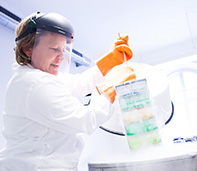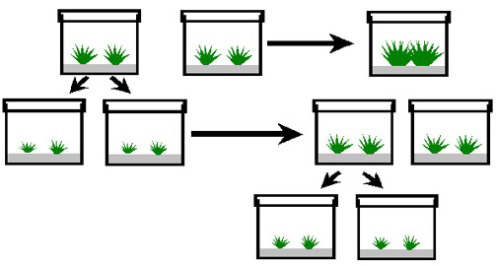DNA and tissue repositories
DNA and tissue repositories contain samples of tissue or blood from plants or animals, but not complete specimens. The samples are preserved either in a frozen state, or by growing new plant tissue in an artificial environment. In this way, the genetic content of the samples can be maintained for extremely long timespans into the future.
The DNA and tissue repositories are a high-tech development of museum collections. Here, two kinds of repositories are described: cryogenic gene banks and living tissue repositories.
Cryogenic gene banks
Repositories containing frozen DNA and tissue are known as “cryogenic gene banks”. They are gene banks where samples of blood or tissue are kept at -156 °C or -196 °C in liquid nitrogen. At such a low temperature, all cellular activity ceases, and in principle the samples can be maintained indefinitely.

(Photo: Lennart Søgård-Høyer)
In principle, plant material can be stored indefinitely and still maintain its ability to regenerate, when it is brought into tissue cultivation after defrosting.
Development of procedurals and techniques for freezing various tissue and blood samples in liquid nitrogen are also very demanding in terms of resources, and the cryogenic containers must continually be topped up with liquid nitrogen.
The frozen cryogenic gene bank also presupposes that specific tissue cultivation procedures have been developed for the reestablishment of unfrozen plant samples.
Living tissue repositories
”Living” repositories are also known as in vitro tissue banks. In these, tissue from plants is grown and maintained; the plant tissue has been sterilized and must subsequently develop and grow on an artificial substrate with the correct nutrients. During the process, the plants are continually split and transferred to new, fresh substrates. In vitro tissue banks are therefore “active gene banks”, which require large amounts of resources to take care of and maintain. Also, not all kinds of plants can be maintained in a tissue culture.
Growing plants in tissue cultivation
A very large effort is needed to transfer new plants into a tissue culture, and it is not possible for all species of plants. The main work effort goes into making the plant material sterile, and to develop and adapt suitable substrates for tissue cultivation. They are therefore “active collections”, which require serious amounts of effort and resources to develop and maintain.
The primary work around maintaining plants in an in vitro tissue bank consists of splitting plants and transferring them to a new substrate every month. As a rule of thumb, there are always three cultures of every species in the tissue bank. One “old” culture, which functions as a living backup copy, and two cultures with newly-transferred plants, which make up the active tissue bank. Each month, the plants from one of these “last month’s new cultures” are split and transferred into two new cultures. The other one of “last month’s new cultures” becomes the new living backup copy, and the old backup copy is discarded.

